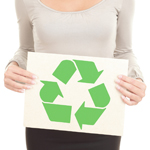With the catastrophic events unfolding across the globe, it’s natural for people to begin to lose faith. The tragic earthquake and tsunami in Japan makes it seem like there’s little one person can do. Now more than ever, it’s important to pick up habits in our every day lives to preserve our planet.
In honour of Earth Hour 2011 (Saturday, March 26) – where people around the world will flick off their lights to fight against climate change – it serves as a gentle reminder that we can care for our world by controlling what we do. Read on for ways to make your life (and everyone elses!) a whole lot greener:
Dim the lights. How often do your lights stay on compared to off? If you keep em’ lit more than dim, it’s time to rid this habit. Turns out artificial lighting counts for 15 per cent of an average home’s electricity use. So soften your lighting to cut down on energy, and your electricity bill. Pst – try using florescent lighting (those twisty looking bulbs). They use 1/6 the amount of energy as the standard ones, while glowing just as vibrantly.
Eat less meat. No, this is not a plea for all meat lovers of the world to become vegetarian. But what if you were told livestock production is one of the largest contributors to climate change? Here’s why: factory farms generate a fifth of the world’s greenhouse gas emissions. This is more than the amount of gas released by all forms of transportation combined. Eek! The solution? Replace one meat meal a week with a veggie alternative. If this was done by every person in the country, the amount of carbon dioxide we’d save would be comparable to removing a half million cars from the road. Talk about a cleaner lifestyle.
Unplug those outlets. Chances are we’ve all been an offender of this ecological misdemeanor. Whether it be a phone charger or light chord, we often leave gadgets plugged into an outlet even if they’re not in use. Just remember: if a device is plugged into the wall, even if it’s switched off, it still wastes energy. Ever touched your phone charger or laptop and realized it was hot enough to cook an egg on? That’s a clear sign of dissipated energy. So when not in use, make sure to disconnect!
Rid the paper napkins and plastic cups. Just as we’re told to trade in our plastic grocery bags for the re-usable alternative, same goes for all other plastic products of the world. To become a more eco-friendly consumer, replace all those plastic and paper products strewn throughout the house with fabric. While paper is biodegradable, the chemicals used to process and bleach them can be extremely harmful to the environment.
Support your local farmers. If we want to lead a greener lifestyle, we should reduce the distance our meal travels from the field to our dinner plate. Transporting food throughout the world emits mass amounts of greenhouse gases each year, just to reach a grocery store. How do we control this? Purchase locally grown organic products as often as possible! While prices are higher for all things organic, the money you save from buying cheap can become more of an expense down the road.
Don’t flush unless you must. While at first this sounds like an odd request, you’d be surprised at how much water we waste by flushing. How much, you ask? The average toilet uses three to five gallons of water every time we press down that lever. And there’s more: when you mistake the toilet for the trash bin (ie. throwing down facial tissues or a cigarette butt) you’re also washing away two extra gallons. Here’s the solution: cut back on the number of times you flush, or buy a low flush toilet. This eco-friendly appliance uses half the amount of water as a standard one.












